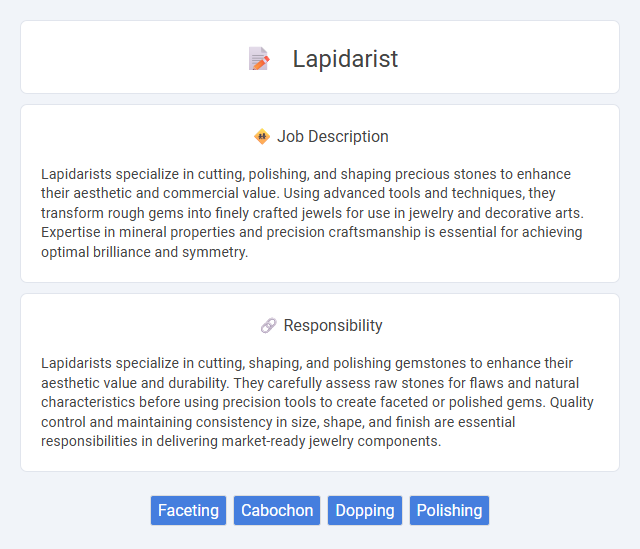
Lapidarists specialize in cutting, polishing, and shaping precious stones to enhance their aesthetic and commercial value. Using advanced tools and techniques, they transform rough gems into finely crafted jewels for use in jewelry and decorative arts. Expertise in mineral properties and precision craftsmanship is essential for achieving optimal brilliance and symmetry.
Lapidary work may be suitable for individuals with steady hands, good eyesight, and patience, as precision is key in cutting and polishing stones. People who experience chronic pain or severe vision impairments might find the detailed, repetitive nature challenging or unsuitable. Those who prefer a controlled, indoor environment and can maintain focus for extended periods are more likely to thrive in this profession.
Qualification
A Lapidarist requires specialized training in gemstone cutting, polishing, and shaping techniques, often obtained through vocational courses or apprenticeships. Proficiency in using precision tools like faceting machines and polishing wheels is essential to enhance the quality and value of gemstones. Strong attention to detail, knowledge of gem properties, and experience in grading are critical qualifications to excel in this craft.
Responsibility
Lapidarists specialize in cutting, shaping, and polishing gemstones to enhance their aesthetic value and durability. They carefully assess raw stones for flaws and natural characteristics before using precision tools to create faceted or polished gems. Quality control and maintaining consistency in size, shape, and finish are essential responsibilities in delivering market-ready jewelry components.
Benefit
Lapidarists likely experience benefits such as developing highly specialized skills in gemstone cutting and polishing, which can lead to increased job opportunities and job security. The role may offer satisfaction from creating visually stunning and valuable jewelry components, potentially boosting confidence and creativity. There is a probability of earning a competitive wage due to the precision and expertise required in the trade.
Challenge
A lapidarist likely encounters intricate challenges in shaping and polishing gemstones to achieve precise cuts and optimal brilliance. Mastery over delicate tools and materials suggests a high probability of facing detailed, repetitive work that demands both skill and patience. The complexity of working with various types of stones may require continuous learning and adaptation to maintain quality standards.
Career Advancement
Lapidarists specializing in gemstone cutting and polishing can advance their careers by mastering advanced techniques such as precision faceting and laser cutting technology. Progression often involves gaining expertise in evaluating gemstone quality and branching into jewelry design or appraisal roles. Certification from recognized gemological institutes and building a portfolio of high-quality work are key factors driving career growth in this field.
Key Terms
Faceting
A lapidarist specializing in faceting expertly cuts and polishes gemstones to enhance their brilliance and optical properties. Precise angles and symmetry are meticulously calculated to maximize light reflection and refraction within the stone, creating optimal sparkle. Advanced tools such as faceting machines and magnification devices are essential to achieve fine details and flawless finishes.
Cabochon
A lapidarist specializing in cabochon cutting expertly shapes and polishes gemstones into smooth, rounded, and domed surfaces without facets, enhancing the stone's natural beauty and color. Precision in controlling angles and curves is essential to achieve the desired luster and durability for use in jewelry such as rings, pendants, and earrings. Mastery of various materials, including agate, opal, and turquoise, is crucial for producing high-quality cabochons that meet market demand.
Dopping
Lapidarists specialize in shaping and polishing gemstones to enhance their natural beauty and maximize value. Dopping is a crucial technique where stones are securely attached to a stick using wax or adhesive, allowing precise control during cutting and polishing. Mastery of dopping improves symmetry and surface quality, directly impacting the brilliance and marketability of the finished gem.
Polishing
Lapidarists specialize in polishing gemstones to enhance their brilliance and value by carefully shaping and smoothing rough stones using precision tools and techniques. The polishing process removes surface imperfections and maximizes the gem's optical properties, resulting in a flawless, reflective finish. Mastery of various polishing compounds and laps ensures the gem's facets achieve optimal light refraction and aesthetic appeal.
 kuljobs.com
kuljobs.com